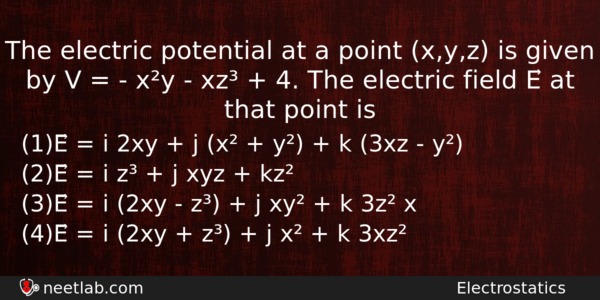| ⇦ | 
| ⇨ |
The electric potential at a point (x,y,z) is given by V = – x²y – xz³ + 4. The electric field E⃗ at that point is
Options
(a) E⃗ = i 2xy + j (x² + y²) + k (3xz – y²)
(b) E⃗ = i z³ + j xyz + kz²
(c) E⃗ = i (2xy – z³) + j xy² + k 3z² x
(d) E⃗ = i (2xy + z³) + j x² + k 3xz²
Correct Answer:
E⃗ = i (2xy + z³) + j x² + k 3xz²
Explanation:
The electric field at a point is equal to negative of potential gradient at that point.
E⃗ = – ?V/ ?r = [ -?V/ ?x i – ?V/ ?y j – ?V/ ?z k ]
E⃗ = i (2xy + z³) + j x² + k 3xz²
Related Questions: - The current flowing through a lamp marked as 50 W and 250 V is
- If the angle of minimum deviation is 60° for an equilateral prism, then the refractive
- If a carnot engine is working with source temperature at 227⁰C and sink
- The ionisation potential of hydrogen-atom is -13.6 eV. An electron in the groundstate
- In one dimensionsal motion,instantaneous speed v statisfies 0⦤v⦤vₒ
Topics: Electrostatics
(146)
Subject: Physics
(2479)
Important MCQs Based on Medical Entrance Examinations To Improve Your NEET Score
- The current flowing through a lamp marked as 50 W and 250 V is
- If the angle of minimum deviation is 60° for an equilateral prism, then the refractive
- If a carnot engine is working with source temperature at 227⁰C and sink
- The ionisation potential of hydrogen-atom is -13.6 eV. An electron in the groundstate
- In one dimensionsal motion,instantaneous speed v statisfies 0⦤v⦤vₒ
Topics: Electrostatics (146)
Subject: Physics (2479)
Important MCQs Based on Medical Entrance Examinations To Improve Your NEET Score
18000+ students are using NEETLab to improve their score. What about you?
Solve Previous Year MCQs, Mock Tests, Topicwise Practice Tests, Identify Weak Topics, Formula Flash cards and much more is available in NEETLab Android App to improve your NEET score.
Share this page with your friends

Leave a Reply